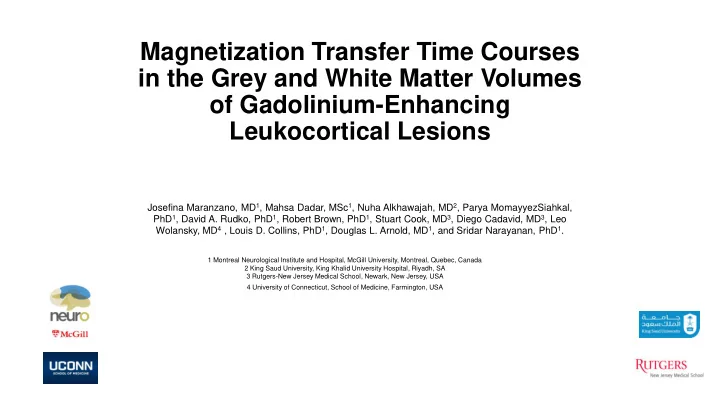

Magnetization Transfer Time Courses in the Grey and White Matter Volumes of Gadolinium-Enhancing Leukocortical Lesions Josefina Maranzano, MD 1 , Mahsa Dadar, MSc 1 , Nuha Alkhawajah, MD 2 , Parya MomayyezSiahkal, PhD 1 , David A. Rudko, PhD 1 , Robert Brown, PhD 1 , Stuart Cook, MD 3 , Diego Cadavid, MD 3 , Leo Wolansky, MD 4 , Louis D. Collins, PhD 1 , Douglas L. Arnold, MD 1 , and Sridar Narayanan, PhD 1 . 1 Montreal Neurological Institute and Hospital, McGill University, Montreal, Quebec, Canada 2 King Saud University, King Khalid University Hospital, Riyadh, SA 3 Rutgers-New Jersey Medical School, Newark, New Jersey, USA 4 University of Connecticut, School of Medicine, Farmington, USA
Objective To compare magnetization transfer evolution in the GM and WM regions of gadolinium-enhancing leukocortical lesions, before and after the gadolinium- enhancement event. Background : Our previous work has shown that Gd+ LCLs, although not frequent (6% of all enhancing lesions) do affect a considerable number of recently diagnosed relapsing-remitting MS patients (36% in our cohort) 1 1. Maranzano J, Rudko DA, Nakamura K, Cook S, Cadavid D, Wolansky L, Arnold DL, Narayanan S. MRI evidence of acute inflammation in leukocortical lesions of patients with early multiple sclerosis. Neurology 2017; 89 (7) 714-721.
Methods 25 early-stage MS patients with 3T MRI monthly scans with triple dose gadolinium 78 Gd+ LCLs separated into WM and GM ROIs T1-w Post- Gad T-2 T-1 T+2 T+1 T0 = gd+ timepoint Propagation backward Propagation forward T-1 T-2 T+1 T+2 Fat Sat MTR
Results: GM & WM Gd+ lesion MTR time courses Matlab R 2017a. Mixed effect model Mean MTR ~ 1 + TissueType * Event + TissueType * Resolution + Time : Event + (1 | subjectID) + (1 | LesionID) Gd+ WM ROI + Gd+ GM ROI NAWM ROI NAGM ROI Fat Sat MTR (mean)
Results: Gd+ lesions that resolve or not on T2/FLAIR Post-hoc single factor analysis in different tissue types of resolved and non-resolved lesions. Mean MTR ~ 1 + Event + (1 | subjectID) + (1 | LesionID) Gd+ WM ROI Lesions that do not resolve Lesions that resolve + Gd+ GM ROI NAWM ROI NAGM ROI Fat Sat MTR (mean)
Conclusion MTR decreases in the GM portion of LCLs after Gd enhancement suggest that at least some cortical demyelination is due to BBB breakdown The persistence of the MTR decreases over time, even in LCLs that resolve on conventional MRI, may underlie observations of low normal-appearing cortical MTR in MS patients
Acknowledgements • Sridar Narayanan, PhD • Douglas Arnold, MD • David Rudko, PhD • Kunio Nakamura, PhD • Stuart Cook, MD • Nuha Alkhawajah, MD • Diego Cadavid, MD • Robert Brown, PhD Rutgers-New Jersey Medical School, • Parya Momayyezsiahkal, PhD Newark, New Jersey, USA • Dante Dinigris, PhD • Simon Francis, MSc • Haz-Edine Assemlal, PhD • Leo Wolansky, MD • Dumitru Fetco, MD University of Connecticut, School of Medicine, • Aki Caramanos, MSc Farmington, CT, USA • Rozie Arnaoutelis Magnetic Resonance Studies Laboratory, Montreal Neurological Institute, McGill University The BECOME study was supported by Bayer Schering Pharma, but was investigator-initiated and remains the • Mahsa Dadar, MSc intellectual property of Rutgers – New Jersey Medical School, Newark, New Jersey. • Louis Collins, PhD NeuroImaging and Surgical Tools Laboratory, John McCrae Fellowship, Faculty of Medicine of McGill Montreal Neurological Institute, McGill University University supports Josefina Maranzano
Recommend
More recommend